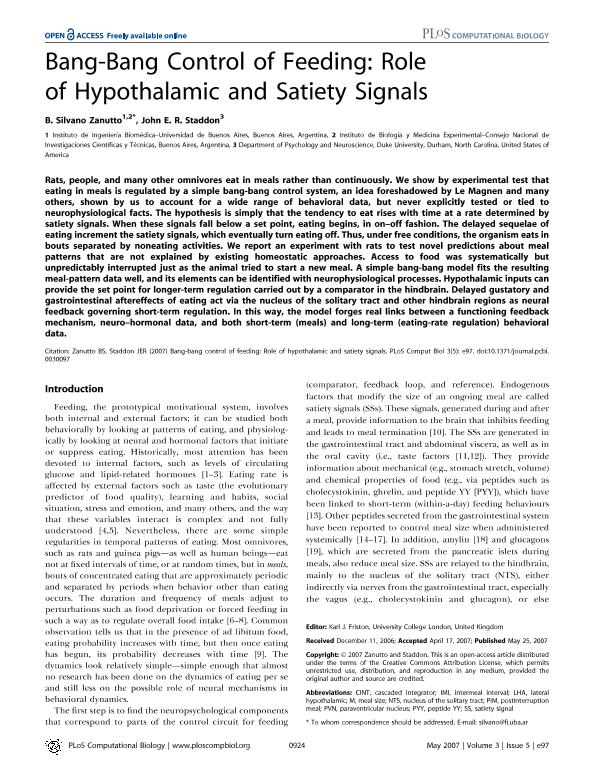Artículo
Bang-bang control of feeding: role of hypothalamic and satiety signals
Fecha de publicación:
2007
Editorial:
Public Library of Science
Revista:
Plos Computational Biology
ISSN:
1553-7374
e-ISSN:
1553-7358
Idioma:
Inglés
Tipo de recurso:
Artículo publicado
Clasificación temática:
Resumen
Rats, people, and many other omnivores eat in meals rather than continuously. We show by experimental test that eating in meals is regulated by a simple bang-bang control system, an idea foreshadowed by Le Magnen and many others, shown by us to account for a wide range of behavioral data, but never explicitly tested or tied to neurophysiological facts. The hypothesis is simply that the tendency to eat rises with time at a rate determined by satiety signals. When these signals fall below a set point, eating begins, in on–off fashion. The delayed sequelae of eating increment the satiety signals, which eventually turn eating off. Thus, under free conditions, the organism eats in bouts separated by noneating activities. We report an experiment with rats to test novel predictions about meal patterns that are not explained by existing homeostatic approaches. Access to food was systematically but unpredictably interrupted just as the animal tried to start a new meal. A simple bang-bang model fits the resulting meal-pattern data well, and its elements can be identified with neurophysiological processes. Hypothalamic inputs can provide the set point for longer-term regulation carried out by a comparator in the hindbrain. Delayed gustatory and gastrointestinal aftereffects of eating act via the nucleus of the solitary tract and other hindbrain regions as neural feedback governing short-term regulation. In this way, the model forges real links between a functioning feedback mechanism, neuro–hormonal data, and both short-term (meals) and long-term (eating-rate regulation) behavioral data.
Archivos asociados
Licencia
Identificadores
Colecciones
Articulos(IBYME)
Articulos de INST.DE BIOLOGIA Y MEDICINA EXPERIMENTAL (I)
Articulos de INST.DE BIOLOGIA Y MEDICINA EXPERIMENTAL (I)
Citación
Zanutto, Bonifacio Silvano; Staddon, John E.; Bang-bang control of feeding: role of hypothalamic and satiety signals; Public Library of Science; Plos Computational Biology; 3; 5; -1-2007; 924-931
Compartir
Altmétricas




